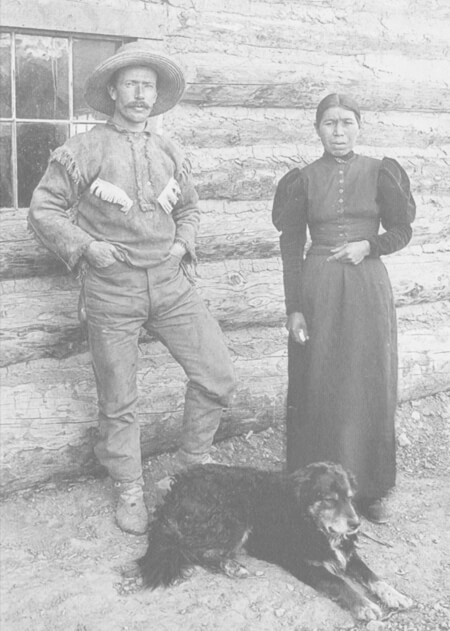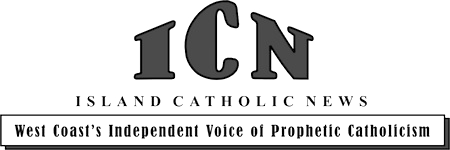Unmarked Graves, Church Structure, and the Pope
by Gerald Archibald, Edmonton
Volume 35 Issue 7, 8 & 9 | Posted: October 4, 2021

Like thousands of Canadians and virtually all the First Nations and Metis people in Canada, I was dumbstruck and heartbroken by the revelation of the discovery of unmarked graves at the Kamloops Residential School grounds (200 such graves at this location situated on the Tk’emlups te Seewepemc First Nation) and the Marieval Residential School in Saskatchewan (751 graves at the site located on the Cowessess First Nation).
To be sure, there was a national response by the lowering of the flags across the country as well as the hundreds of memorial sites where people placed cards, flowers, and shoes in front of former residential school sites, diocesan centres, and many churches throughout the land.
There were several church leaders who took to the media to comment upon these discoveries. While I found most of these apologies and comments defensive and/or superficial in nature, I also thought there were some bishops and archbishops who went the extra mile.
Some of these church representatives met with indigenous leaders and spoke directly and sincerely about the terrible role the church played in the whole residential school disaster and the subsequent church’s role in the unmarked graves situation (Archbishop Smith in Edmonton was one of the first in Canada to do this, if not the first; the Bishop of Saskatoon and the Redemptorists held a four day ‘wake’ at St. Mary’s Parish are examples). But many of the so-called apologies were unbelievably weak.
2.
The interview Cardinal Collins of Toronto recently gave, while offering some words of comfort and apology, was defensive in his apparent explanation that the church is not one entity, but a series of thousands of dioceses: “Each diocese and institute is corporately and legally responsible for its own actions” (Toronto Star, June 4, 2021).
He also gave an interview on CBC television which I watched with dismay. It also appeared very defensive and did not support Pope Francis coming to Canada to meet with Indigenous leaders to sincerely apologize for the church’s role in the residential school debacle and subsequent burial of students in unmarked graves. He basically said the Prime Minister of Canada didn’t know what he was talking about when he sided with the Indigenous community in asking the Pope to come to Canada by reverting to ‘legalese’ in the description of how dioceses are legally separate entities.
I was embarrassed by most of the media interviews. The underlying message seemed to be that it is impossible to get the Vatican involved due to how the dioceses are set up. Does the average Catholic, or Canadian for that matter, understand these legal arguments? Is any of this Christ like?
The extensive work done by the Truth and Reconciliation Commission (TRC) issued in 2015 had several recommendations directly addressed to the Church. In my opinion, the TRC was a very credible piece of work, and should be the blueprint for the future for the federal government and the various Christian churches involved in the residential school catastrophe.
Recommendation #58 is addressed directly to the Catholic Church. It states:
We call upon the Pope to issue an apology to Survivors, their families, and communities for the Roman Catholic Church’s role in the spiritual, cultural, emotional, physical, and sexual abuse of First Nations, Inuit, and Métis children in Catholic-run residential schools. We call for that apology to be similar to the 2010 apology issued to Irish victims of abuse and to occur within one year of the issuing of this Report and to be delivered by the Pope in Canada.
The Catholic Church cannot have it both ways, saying on one hand that each diocese is autonomous and a legal corporation responsible for its own affairs, and on the other hand saying the Pope is the head of the Church. Let’s talk practicalities here: When we ask who the head of Amazon is, most informed people would know it was Jeff Bezos until recently. Similarly, most would know Elon Musk is the head of Tesla. If you ask virtually anyone who is the head of the Catholic Church, the answer would clearly be Pope Francis.
3.
I happen to have met a member of one of the First Nations where unmarked graves were discovered. This person said that she was deeply affected as many of those people in these graves would likely be her relatives. She is trying to get her mind around this traumatic discovery. She also mentioned that members of her First Nation realize, that without accurate record keeping, some of the graves may be in fact signify the end of particular bloodlines.
Imagine how most of the indigenous people in Canada are trying to come to grips with these terrible findings. Imagine as well how our indigenous communities are viewing the Catholic Church’s various responses, especially those given from those in the highest positions of the Canadian Catholic Church. It is true that some leaders have made unqualified apologies, but none in my knowledge have endorsed the recommendation that Pope Francis needs to come to Canada. (see article “AFN Hopes Vatican Meeting with Pope Will Lead to Apology Visit” in Other News)
Let’s stop and think for a minute: how would we feel if members of our individual ancestral family of 3-5 generations ago were buried in unmarked graves, without the knowledge or involvement of the surviving family members? Can you imagine how you would feel? No records, no ceremonies, not even verbal communication with families! And in the case of at least one of the grave sites, instructions were given by the clergy in charge to remove crosses at each grave.
A review of sociological and anthropological literature indicates that dominant cultures do not regard or treat minority cultures as equal. To be fair, this inclination is rooted deep within the larger dominant society to the point most of us are not aware of our biases. Yet study after study verify this fact.
4.
I have talked with many people about the unmarked graves discoveries. More than once, I encountered negative views, such as ‘I’m sick and tired of all the apologies. The church apologized for their role in residential schools, and there has recently been some more made regarding the unmarked graves. Enough is enough’. In my way of thinking, these sentiments come from people in dominant societies, and as such, have a great deal of difficulty understanding what is really happening here. Again, is this Christ like?
Often these discussions bring up the fact that they know former students of residential schools who say their school experiences were positive. I too know a few former students who have this point of view. I know of Sisters who taught at some of these schools, Sisters who are very kind and well intentioned, but are heart broken at all the tragic experiences that emerged through the TRC process.
The TRC and the extensive research it adopted in arriving at its conclusions, clearly verified that serious harm was caused to our indigenous brothers and sisters for nearly 150 years. Imagine how the residents of these schools who are still alive, and the hundreds and hundreds of relatives of deceased residents, and virtually the whole indigenous community in Canada feel about the discoveries of unmarked graves!
5.
An accomplished writer and regular columnist for several newspapers, Dave Cuthand, wrote recently in the August 26, 2021, Edmonton Journal about the Papal Bull issued by Pope Alexander VI in 1493 and the disastrous consequences for the inhabitants of countries not yet discovered by the Europeans. “Pope Alexander VI decreed that all lands not inhabited by Christians were available to be discovered, claimed, and exploited by Christian rulers. Since Christianity was European, it also meant white supremacy was spread with European colonization”.
This papal instruction is also known as the Doctrine of Discovery. Within 50 years after the destruction of the Aztec Empire, the Spanish had conquered South and Central America. This led to other European nations laying claim to countries all around the world including North America.
We as a Canadian people are descendants of the Doctrine of Discovery. We grew up within this far-reaching doctrine, and technically still live within it. Deep rooted biases were formed and are with us today. Most of us, including myself, are part of the dominant culture. This is the root of the origins of the residential school system designed to take the ‘Indian out of the Child’ and the subsequent outcomes.
Such outcomes included the way young children were taken away from their parents, the treatment of those boys and girls at the schools, the shoddy record keeping of the deaths of thousands of these children (including the burial of many in unmarked graves), the parents of the dead children not knowing what happened to them, and on and on.
Another argument I hear is that indigenous people could not know about unmarked graves. One of the established facts in anthropological history is the importance of oral tradition. In most indigenous communities, history was passed down from generation to generation by way of oral means. The elders are often called ‘knowledge keepers’. They pass on the stories they received from their elders. Remember the decades and decades scientists looked for the ships of the Franklin Expedition. The many searches proved fruitless until someone decided to ask the Inuit in neighbouring regions if they heard of such ships in stories passed down to them from prior generations.
Once these ‘knowledge keepers’ were consulted, it did not take long to find the ships. The same holds true regarding the stories passed down about areas around residential school sites, and that the community knew by way of oral tradition that residents were buried nearby. Older school survivors even talk about being called to dig graves in the middle of the night.
With all this being said, I strongly believe we must let and encourage our indigenous fellow Canadians lead the process of what should happen next regarding the future chapters in this long unfortunate story. We need to respect our minority cultures, listen carefully to them, collaborate with them, and let them take the lead on the next steps of reconciliation. Our version of history, being written and passed down by the dominant culture, has been shown to be lacking in many aspects.
It is time to walk into the future together. Most importantly, Pope Francis needs to come to Canada and meet with our indigenous representatives and apologize for the role the Catholic Church played in the residential school and unmarked graves saga! This Christ like action would have unbelievable significance to our indigenous people as well as those who are journeying with them.
Feedback welcome: archibaldjerry@gmail.com
by Gerald Archibald, Edmonton
